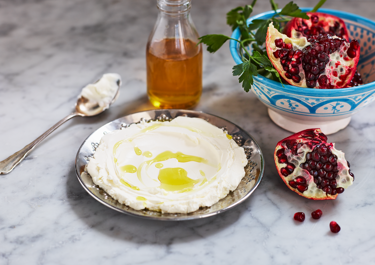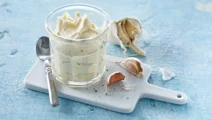
Labneh

Instructions
Tips
You can preserve it in olive oil for months. This preservation method, however, requires a thicker labneh and is, as such, more time-consuming as it needs to strain for 48 hours as opposed to just 24 hours. The longer straining times give it a thicker texture that allows you to fashion it into small balls (about 2 cm in diameter). Chill these balls overnight before completely submerging them in high-quality olive oil in a clean mason jar.
Questions about labneh
With a simple labneh recipe like ours, making this versatile Middle Eastern staple is wonderfully easy. To learn more about it, read our answers to the most frequently asked questions about it below.
Ingredients
Whole milk yoghurt, naturel or Greek inspired yoghurt, 10% | 1 l |
|---|---|
Salt | 1 tsp |
Olive oil | 2 tbsp |
Homemade labneh made from yoghurt
Labneh has a tangy and slightly sour flavour that is similar to cream cheese but has a distinct Middle Eastern twist. It is a versatile ingredient that can be used as a spread or dip and pairs well with a range of flavours, such as herbs, spices, and olive oil.
One of the benefits of making it at home is that you can customise the flavour to your liking. For example, you can add garlic, lemon juice, or other seasonings and spices to the yoghurt before straining it to create a unique flavour profile.
Creamy, thick, and tangy yoghurt cheese
Labneh is a type of Middle Eastern fresh cheese that is made by straining either goat or cow whole milk yoghurt until it gains a thick and creamy consistency. The yoghurt is mixed with salt and left to strain for several hours, which removes the whey (the liquid component of milk) and results in a rich and tangy flavour.
Its texture is smooth and creamy, with a spreadable consistency similar to cream cheese. It has a distinct sour and salty taste, with hints of tanginess that make it a popular savoury ingredient in dips, spreads, and dressings.
Delicious uses for labneh
The tangy flavour and creamy consistency of labneh make it great for a vast array of different dishes. It can be enjoyed on its own or served as a base for various toppings, such as olive oil, herbs, and spices.
As a dip, it tastes great with crunchy vegetables like sweet carrots, peppery radishes, and mild cucumber sticks. If you want to make an even heartier snack for your meze table, you can serve it with homemade flatbread or pita bread for dipping. You can also use it as a spread in sandwiches and on bagels, just like you would cream cheese.
Throughout the Middle East, this tasty dip is also enjoyed at breakfast, for instance, with pancakes. Try serving fluffy American pancakes topped with labneh, honey, and either fresh or dried berries for a breakfast or brunch dish that is sweet, savoury, and scrumptious.
Make spiced labneh with dukkah, za'atar, garlic, harissa, or other flavours
Experimenting with different kinds of flavours is as fun as it is tasty! Some popular choices include serving labneh with za'atar or other spices either mixed into the pre-strained yoghurt or sprinkled on top as a decorative seasoning. Za'atar is a Levantine spice blend with salt, sesame seeds, and dried herbs like sumac, oregano, basil, and thyme. Za'atar is full of nutty, lemony, and herbaceous flavours and, as such, makes for an incredibly aromatic seasoning.
If you enjoy bold flavours, you might also like to try an aromatic, slightly sharp garlic labneh dip. If nutty flavours are more up your alley, dukkah is a perfect choice, and you can use our dukkah recipe to make the Middle Eastern spice blend yourself.
If you want to experiment with colour as well as flavour, you can use beetroot to give it a vibrant pink colour and a sweet, earthy flavour, or Middle Eastern chilli paste to make a spicy, red harissa labneh dip flavoured with the paste's roasted red peppers, cumin, coriander, and caraway seeds.










